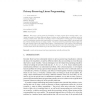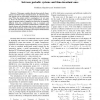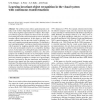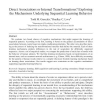3256 search results - page 33 / 652 » Learning Linear Transformations |
OL
2011
13 years 2 months ago
2011
Abstract. We propose a privacy-preserving formulation of a linear program whose constraint matrix is partitioned into groups of columns where each group of columns and its correspo...
CDC
2008
IEEE
14 years 2 months ago
2008
IEEE
— This paper considers discrete-time periodic linear systems and their Floquet transformations, by which the periodic systems can be equivalently transformed to time-invariant on...
CDC
2009
IEEE
13 years 11 months ago
2009
IEEE
Abstract-- This paper considers when a discrete-time periodic non-homogeneous system can be transformed to a time-invariant one by using regular linear mappings of state variables,...
BC
2006
13 years 7 months ago
2006
Abstract The cerebral cortex utilizes spatiotemporal continuity in the world to help build invariant representations. In vision, these might be representations of objects. The temp...
COGSCI
2010
13 years 7 months ago
2010
We evaluate two broad classes of cognitive mechanisms that might support the learning of sequential patterns. According to the first, learning is based on the gradual accumulation...




